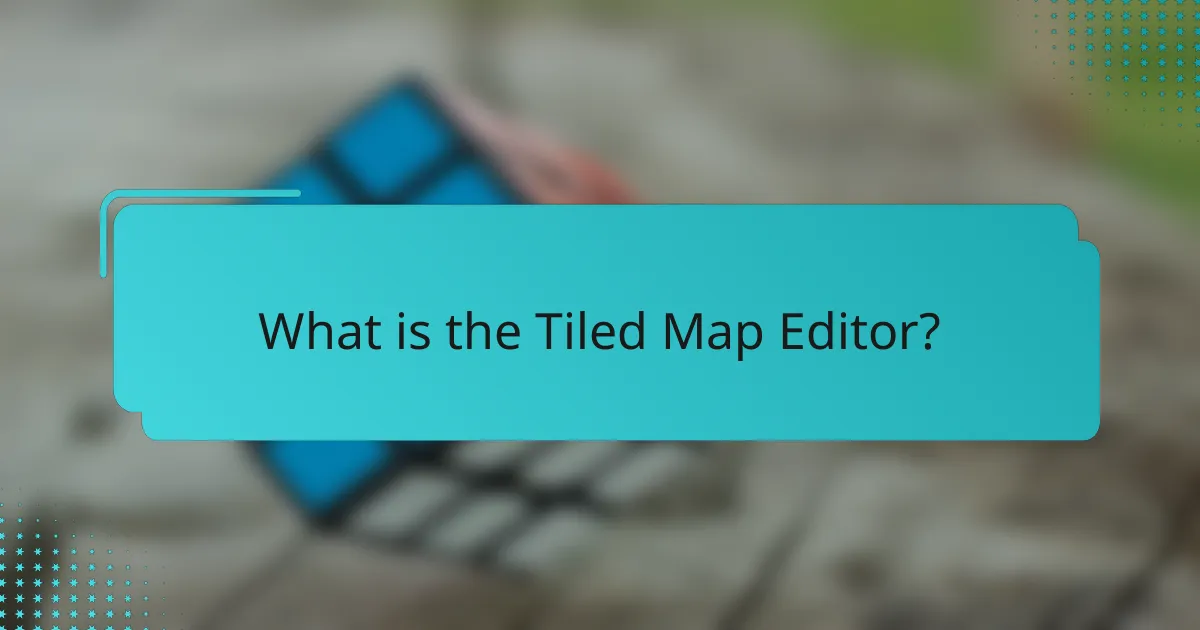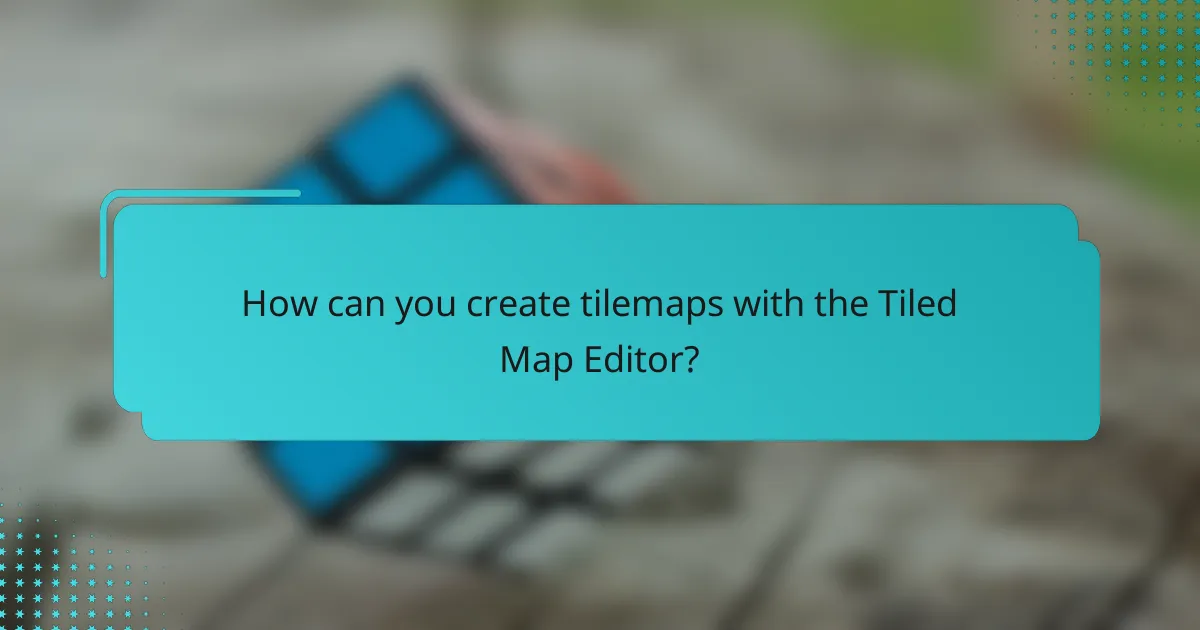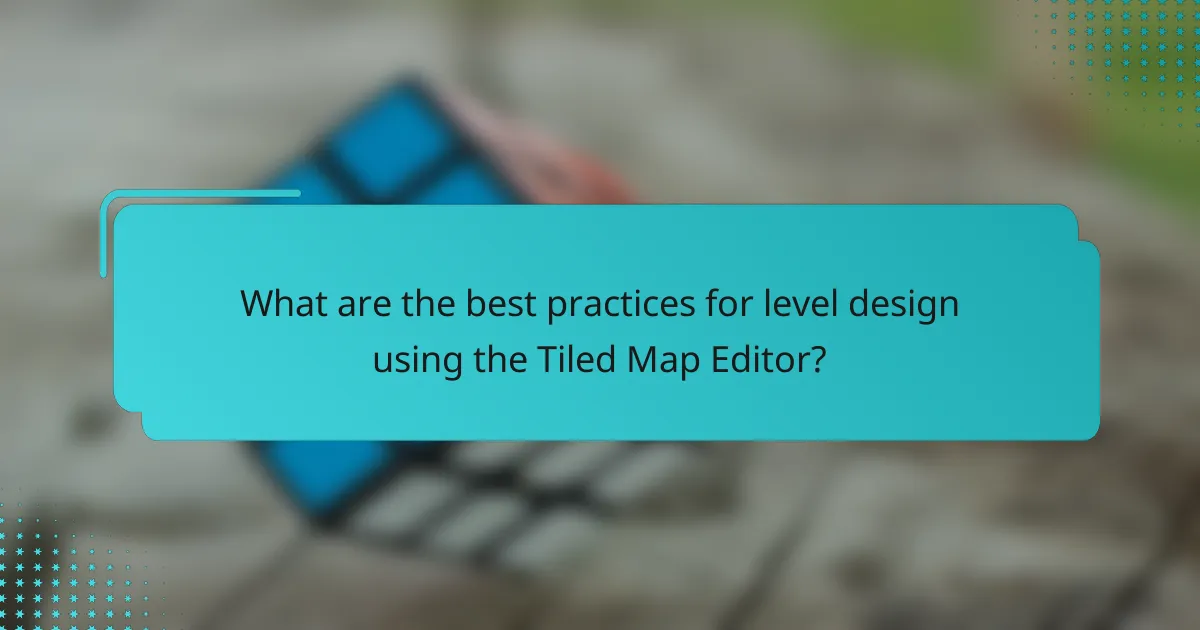
What is the Tiled Map Editor?
The Tiled Map Editor is a flexible tool used for creating tile-based maps. It allows users to design levels for 2D games using tilesets. The editor supports various formats, including JSON and XML, for easy integration with game engines. It features layers for organizing tiles, objects, and collision data. Tiled is open-source and available on multiple platforms, enhancing accessibility for developers. Its community-driven nature ensures continuous improvement and support. The Tiled Map Editor is widely used in the gaming industry, demonstrating its effectiveness in level design.
How does the Tiled Map Editor function in game development?
The Tiled Map Editor functions as a tool for designing 2D game levels. It allows developers to create tilemaps using a grid-based layout. Users can place tiles from a tileset onto the grid to build environments. The editor supports various layers, enabling the organization of different elements like backgrounds, objects, and collisions. It also features a user-friendly interface for easy manipulation of tiles. Developers can export tilemaps in formats compatible with game engines. This functionality streamlines the level design process, making it efficient and intuitive. The Tiled Map Editor is widely used in the game development community for its versatility and ease of use.
What are the key features of the Tiled Map Editor?
The Tiled Map Editor offers several key features for creating tilemaps. It supports a variety of tile formats, including orthogonal, isometric, and hexagonal layouts. Users can layer tiles for complex map designs. The editor allows for custom properties to be assigned to tiles and objects. It includes a user-friendly interface for easy navigation and editing. Tiled also supports multiple file formats for export, including JSON and XML. Additionally, it provides scripting support for advanced functionality. These features make Tiled a versatile tool for game level design.
How does the Tiled Map Editor support different game genres?
The Tiled Map Editor supports different game genres by providing versatile tools for creating diverse tilemaps. It allows developers to design 2D environments suitable for platformers, RPGs, and puzzle games. The editor supports various tile sizes and layers, enabling the creation of complex maps. It also features customizable properties for tiles, which can be tailored to specific gameplay mechanics. Additionally, Tiled supports multiple file formats, making it compatible with various game engines. The flexibility in layering and object placement facilitates unique level designs across genres. This adaptability is essential for creating engaging experiences in different game types.
What are the advantages of using the Tiled Map Editor?
The Tiled Map Editor offers several advantages for game development. It provides an intuitive interface for creating tilemaps. Users can easily place tiles and design levels visually. The editor supports multiple layers, allowing for complex level designs. It also enables the use of custom tilesets, which enhances creativity. The Tiled Map Editor exports maps in various formats compatible with game engines. This flexibility streamlines the development process. Additionally, it is open-source, making it accessible for developers. These features collectively simplify the level design process and improve productivity.
How does the Tiled Map Editor enhance the level design process?
The Tiled Map Editor enhances the level design process by providing a user-friendly interface for creating tilemaps. It allows designers to easily place tiles on a grid, facilitating rapid level creation. The editor supports various tile sizes and layers, which enables detailed and complex environments. Additionally, it offers features like object placement and custom properties for tiles, enhancing functionality. The integration of multiple file formats increases compatibility with game engines. This flexibility streamlines the workflow, allowing for quick iterations and adjustments. Overall, Tiled Map Editor significantly improves efficiency in level design, making it a valuable tool for game developers.
What makes the Tiled Map Editor user-friendly for developers?
The Tiled Map Editor is user-friendly for developers due to its intuitive interface and extensive features. It allows for easy manipulation of tilesets, enabling developers to create maps quickly. The drag-and-drop functionality simplifies the placement of tiles within the editor. Additionally, the support for multiple layers enhances the complexity of designs without overwhelming the user. Developers benefit from customizable keyboard shortcuts, which streamline workflows. The editor also supports various file formats, making it compatible with different game engines. Comprehensive documentation and community support further assist developers in navigating the tool effectively. These features collectively contribute to a more efficient and enjoyable mapping process.

How can you create tilemaps with the Tiled Map Editor?
To create tilemaps with the Tiled Map Editor, start by downloading and installing the software. Open Tiled and create a new map by selecting the desired dimensions and orientation. Next, import tilesets that contain your graphics. You can do this by navigating to the Tilesets panel and selecting “New Tileset.” After importing, use the Tile Palette to select tiles and place them onto the map grid. You can manipulate tiles by using tools like the Paint tool for drawing and the Selection tool for editing. Save your tilemap in Tiled’s format for future use or export it to a format compatible with your game engine. Tiled supports various export options, including JSON and XML, which can be integrated into game development frameworks.
What steps are involved in designing a tilemap?
Designing a tilemap involves several key steps. First, define the game world layout and dimensions. Next, create or select a tile set that includes all necessary tiles. Then, plan the tilemap structure, determining how tiles will be arranged. After that, use a tilemap editor to place tiles according to the planned structure. Finally, test the tilemap in the game to ensure it functions as intended. Each step is crucial for creating an effective and playable game environment.
How do you import tilesets into the Tiled Map Editor?
To import tilesets into the Tiled Map Editor, first open the Tiled application. Click on “File” in the top menu, then select “New Map” or open an existing map. Next, navigate to the “Tilesets” panel on the right side. Click on the “Add External Tileset” button. A file dialog will appear; locate and select your tileset image file. After selecting the file, confirm the import by clicking “Open.” The tileset will now be added to your map. You can use it by selecting tiles from the tileset panel for your level design.
What techniques can be used to arrange tiles effectively?
Techniques to arrange tiles effectively include grid-based layout, layering, and pattern repetition. A grid-based layout ensures uniformity and alignment, making it easier to manage tile placement. Layering allows for the creation of depth by placing tiles in different visual planes. Pattern repetition contributes to visual consistency and can enhance the aesthetic appeal of the design. Additionally, using snapping tools in a tilemap editor helps maintain precision during the arrangement process. These techniques collectively improve the organization and visual coherence of tilemaps in game design.
How can you optimize tilemaps for performance?
To optimize tilemaps for performance, reduce the number of draw calls. Group tiles into larger textures called texture atlases. This minimizes the number of times the GPU switches textures. Use culling techniques to avoid rendering tiles that are not in view. Implement level of detail (LOD) techniques to reduce the complexity of distant tiles. Limit the number of unique tiles to decrease memory usage. Use simpler tile designs to enhance rendering speed. Finally, leverage spatial partitioning to efficiently manage tile visibility and rendering.
What are best practices for minimizing tilemap size?
To minimize tilemap size, use fewer tiles by creating a limited tile set. This reduces the overall data required to store the map. Implement tile reuse across different areas to avoid redundancy. Optimize tile dimensions to fit the game’s resolution, ensuring that larger tiles are only used when necessary. Utilize compression techniques to reduce file sizes without losing quality. Organize tiles efficiently in the tilemap to streamline rendering processes. These practices enhance performance and loading times in game development.
How does tilemap layering impact game performance?
Tilemap layering significantly impacts game performance by affecting rendering efficiency. Each layer in a tilemap requires additional processing power during rendering. More layers can lead to increased draw calls, which can slow down the frame rate. Additionally, overlapping tiles in multiple layers may result in redundant calculations for visibility. Optimizing the number of layers used can improve performance. For instance, a game using fewer, well-structured layers can maintain a smoother experience. Studies show that reducing draw calls enhances performance in graphics-intensive applications. Therefore, careful management of tilemap layers is crucial for optimizing game performance.

What are the best practices for level design using the Tiled Map Editor?
The best practices for level design using the Tiled Map Editor include planning your layout before implementation. Sketching your level on paper helps visualize the design. Use layers effectively to separate different elements such as backgrounds, collision, and decorations. This organization simplifies editing and debugging. Utilize tile sets efficiently to create a cohesive visual style. Consistent tile usage enhances the player’s experience. Implement grid snapping to maintain alignment and ensure that tiles connect seamlessly. Test your levels frequently to identify and fix issues early. Finally, gather feedback from playtesters to improve level design.
How do you create engaging gameplay experiences with tilemaps?
Engaging gameplay experiences with tilemaps are created by designing interactive and visually appealing environments. This involves using varied tile designs to enhance aesthetic appeal. Incorporating elements like obstacles, power-ups, and enemies adds challenge and excitement. Implementing dynamic elements, such as moving platforms, keeps players engaged. Layering tiles for depth creates a more immersive experience. Utilizing a grid system allows for precise placement of tiles and easier navigation. Testing different layouts helps identify the most engaging configurations. Feedback from players can inform adjustments to improve the overall experience.
What design principles should be considered when using tilemaps?
When using tilemaps, several design principles should be considered. First, maintain a consistent tile size for uniformity. Consistency helps in seamless integration within the game environment. Second, ensure that tiles are designed with clear visual distinction. This aids players in recognizing interactive elements quickly. Third, utilize a grid layout to facilitate alignment and organization. A grid structure simplifies the placement and manipulation of tiles. Fourth, consider layering tiles for depth and complexity. Layering can create a more engaging visual experience. Fifth, incorporate color theory to evoke emotions and guide player behavior. Color can significantly influence player perception and interaction. Lastly, test tilemap designs with actual gameplay scenarios. Testing reveals potential issues and improves overall design effectiveness.
How can you incorporate player feedback into level design?
Incorporating player feedback into level design involves actively collecting and analyzing player opinions and experiences. Developers can use surveys and playtesting sessions to gather insights. This feedback should focus on aspects like difficulty, pacing, and enjoyment. Analyzing player behavior through analytics tools can reveal patterns in gameplay. Iterative design allows for adjustments based on feedback after each testing phase. Engaging with the community through forums and social media can provide additional perspectives. Implementing changes based on this feedback enhances player satisfaction and game quality. Studies show that games designed with player input tend to have higher retention rates and positive reviews.
What common challenges do developers face with the Tiled Map Editor?
Developers face several common challenges with the Tiled Map Editor. One challenge is the learning curve associated with its interface and features. New users may struggle to understand tile properties and layers. Another issue is the integration with game engines. Developers often encounter difficulties when exporting maps to formats compatible with their engines. Performance optimization is also a concern. Large maps can lead to performance issues if not managed properly. Additionally, managing tilesets can be cumbersome. Developers may find it challenging to organize and utilize multiple tilesets effectively. Lastly, debugging issues in map design can be time-consuming. Identifying errors in tile placement or properties requires careful inspection.
How can you troubleshoot issues with tilemap rendering?
To troubleshoot issues with tilemap rendering, first check the tilemap settings in the Tiled Map Editor. Ensure the tile size matches the sprite dimensions. Verify that the correct tileset is applied to the tilemap layer. Inspect the rendering code for any errors or misconfigurations. Make sure that the graphics library or engine supports the tilemap format used. Test the tilemap in a simple environment to isolate the problem. Lastly, consult documentation or community forums for specific rendering issues related to your engine.
What resources are available for learning Tiled Map Editor effectively?
Official Tiled Map Editor documentation is a primary resource for learning the software effectively. It provides comprehensive guides, tutorials, and API references. Online video tutorials on platforms like YouTube offer visual step-by-step instructions. Community forums, such as the Tiled Map Editor subreddit, allow users to ask questions and share knowledge. Additionally, GitHub repositories often contain example projects and user-contributed resources. Game development courses on sites like Udemy or Coursera may include modules on Tiled Map Editor. These resources collectively enhance understanding and practical skills in using Tiled Map Editor for game design.
What tips can help improve your workflow with the Tiled Map Editor?
To improve your workflow with the Tiled Map Editor, utilize keyboard shortcuts for efficiency. Familiarize yourself with the most commonly used shortcuts to speed up your tasks. Organize your tilesets properly to streamline the design process. This organization reduces time spent searching for specific tiles. Use layers effectively to manage different elements of your map. Layers allow for better control over visibility and editing. Regularly save your work to prevent data loss. Implementing a consistent naming convention for your layers and tiles can enhance clarity. Finally, take advantage of the export options to streamline the integration of your maps into your game engine.
The Tiled Map Editor is a versatile tool designed for creating tile-based maps for 2D games, supporting various formats such as JSON and XML. This article provides an overview of its functionalities, including level design techniques, key features, and best practices for optimizing tilemaps. It also addresses common challenges developers face and offers resources for effective learning. By exploring the Tiled Map Editor’s capabilities, developers can enhance their workflow and create engaging gameplay experiences across different game genres.